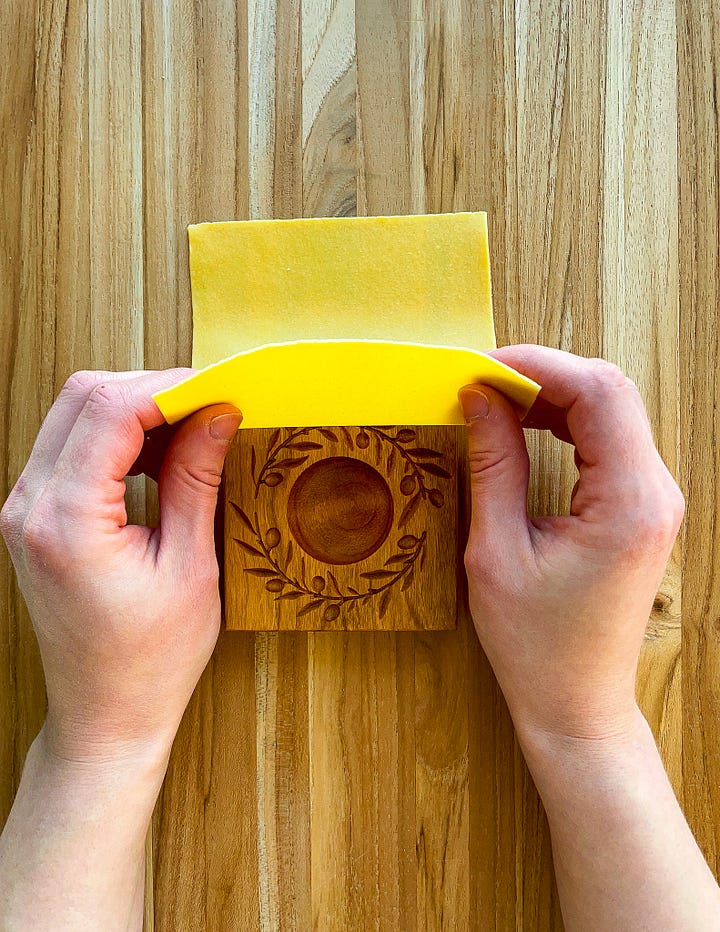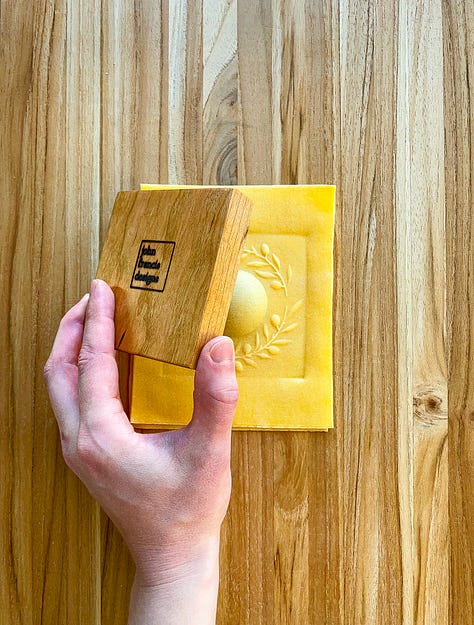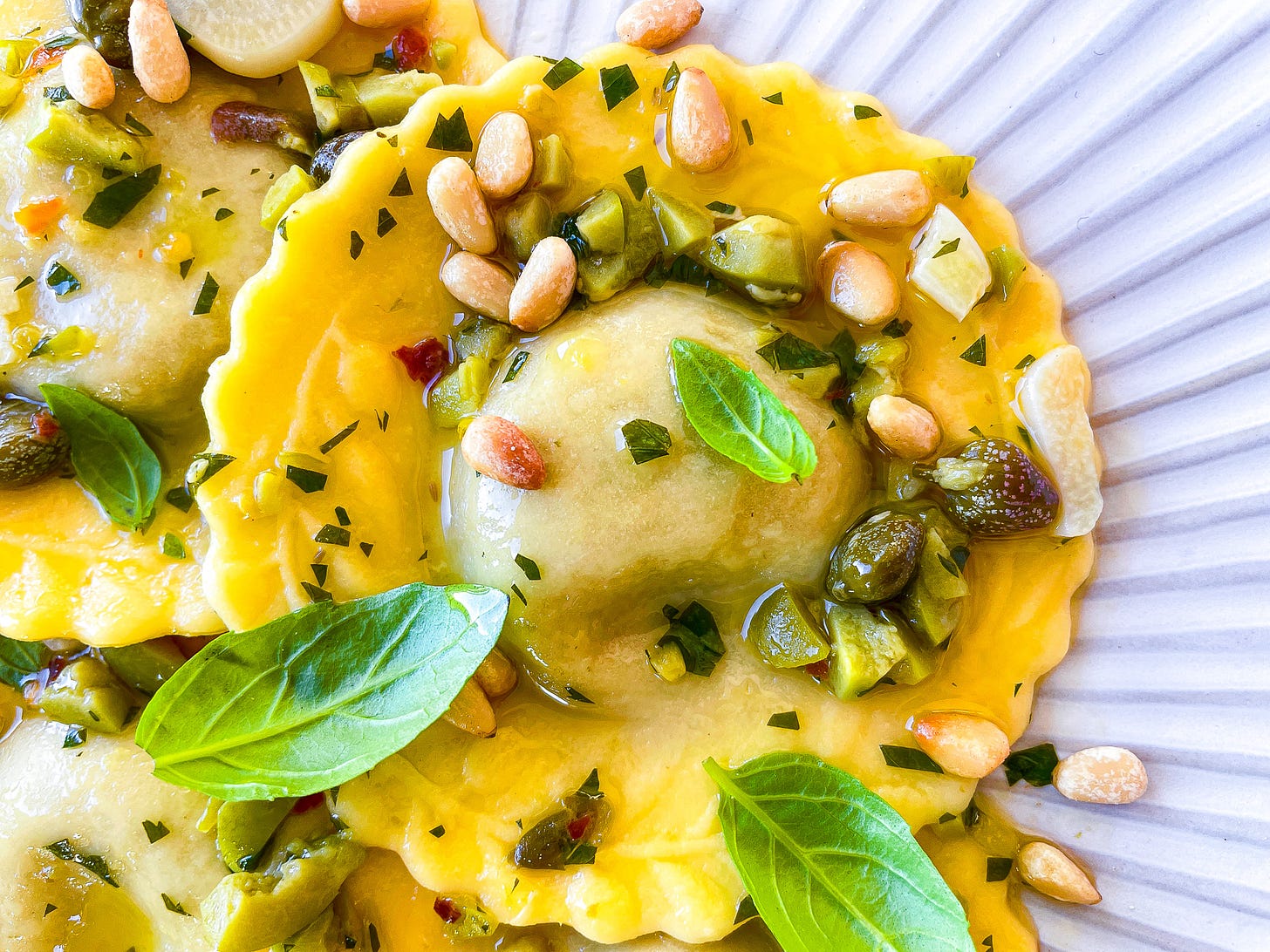It’s officially spring (can you believe it?), and I’m celebrating the only way I know how: with pasta. Not just any pasta, but fancy, springtime pasta, featuring a new ravioli mold by—you guessed it—John Francis Designs. This has become a bit of a habit, and now I can’t imagine marking the changing seasons with anything else. We last left off in October, with pumpkin ravioli best described as Cinderella’s carriage made edible; now, those whimsical autumnal vines have smoothed into the elegant curves of olive branches burgeoning with fruit.
Olives—green and black, small and large—are a cornerstone of Italian cooking, a great unifier in a cuisine known for its regionality. Their oil, of course, is the foundation of most of the country’s dishes, but their salty fruit is also enjoyed in every possible way: stuffed and fried, studded among strands of spaghetti, crowned atop thick cuts of fish and game. For many, it might seem impossible to narrow down a favorite olive-y dish; for me, it’s impossible not to gravitate toward one in particular, and that’s caponata.
Caponata is a sweet and tangy stew-meets-relish from Sicily, and a dish now popular throughout the peninsula. Eggplant is the star of the show, but variations of this condiment abound depending where on the island you are. In many recipes, cubes of eggplant are fried, then cooked down with celery, onions, tomatoes, capers, and—of course—olives. Some add bell peppers, raisins, pine nuts, and/or almonds; all are enriched with sugar and vinegar to impart its signature agrodolce flavor. The result is usually slathered on crusty bread or ladled over fish. But, as with most things in life, it’s also delicious with pasta. (There’s a caponata-inspired pasta salad recipe in my cookbook, which the wonderful
shared with her Department of Salad readers here.)Like its Sicilian muse, this recipe is tangy and briny and dances on your tongue. Tender, caramelized eggplant, creamy burrata, and meaty Castelvetranos form the backbone of the filling which is, as it should be, a little sweet and a little sour. The sauce is more aglio e olio than caponata, built on good olive oil and garlic, but it’s also bejeweled with olives and capers and pine nuts. I often reach for butter sauces when making stuffed pastas, but this dish reminds me that ravioli can be light and bright, too—and a wonderful way to welcome spring.
While we’re at it, here are some other delicious spring-forward recipes from the archive to add to your rotation:
Olive Branch Ravioli
Serves 4
For the filling*
1½ pounds (680 grams; about 2 small) globe, Italian, or Japanese eggplants
3 tablespoons (45 ml) extra-virgin olive oil
Kosher salt and freshly ground black pepper
1 shallot, peeled, root trimmed, and cut into large pieces
4 garlic cloves, unpeeled
2 tablespoons (30 ml) red wine vinegar
2 teaspoons (8 grams) granulated sugar
4½ ounces (125 grams; 1 ball) burrata, blotted dry
1½ ounces (45 grams; about 10) pitted green olives, preferably Castelvetrano, halved blotted dry
*This recipe makes more filling than you’ll need if using this particular ravioli mold (you can, of course, use it for other ravioli and any stuffed pasta). You can halve the recipe if you’d like, make a double batch of pasta, or freeze the leftovers in an air-tight container for future use. The leftover filling also makes a great dip or spread!
For the pasta
1 batch egg pasta dough
For the sauce
⅓ cup (80 ml) mild-flavored extra-virgin olive oil
6 garlic cloves, thinly sliced
½ teaspoon crushed red pepper flakes
2 tablespoons (30 grams) capers in brine, drained and blotted dry
½ cup (75 grams) pitted green olives, preferably Castelvetrano, blotted dry and coarsely chopped
¼ packed cup (10 grams) flat-leaf parsley, finely chopped
4 tablespoons (55 grams) cold unsalted butter, cut into pieces
¾ ounce (20 grams) freshly and finely grated Parmigiano-Reggiano
Zest and juice of ½ lemon
Toasted pine nuts, for serving
Fresh basil leaves, for serving
For the filling
Heat the oven to 450°F. Line a sheet pan with parchment paper.
Trim the stems from the eggplants, then use a vegetable peeler to peel away a few strips of their skin so you’re left with a zebralike pattern and cut them into 1-inch pieces. In a large bowl, toss the eggplant and shallot with the oil and season generously with salt and pepper. Transfer to the sheet pan and nestle the unpeeled garlic cloves among the pieces.


Roast the eggplant until tender and caramelized, about 35 to 40 minutes, stirring halfway through. Whisk together the vinegar and sugar and pour the mixture over the pan of eggplant while still warm. Let cool completely; peel the garlic.
Transfer the eggplant, shallot, and garlic to a food processor. Tear the burrata into large pieces and add them to the food processor as well, along with the olives. Pulse until smooth, scraping down the sides of the bowl as needed. Season to taste with salt and pepper.
Transfer the filling to a bowl or piping bag and chill thoroughly before use, preferably overnight (the filling can be made up to 3 days ahead).
For the pasta
Make the dough:
Make the dough by hand or in a food processor according to the directions in this post. Let the dough rest, tightly wrapped in plastic, at room temperature for at least 30 minutes and up to 2 hours.
Roll the pasta sheets:
Cut off a quarter of the dough and re-wrap the rest. On your work surface, flatten the section of dough with your palm into an oval-shaped pancake that’s about ¼-inch thick. Press the dough between your fingers to thin it out as needed.
Set your pasta machine to its widest setting. Position one tapered end of the oval in the center and roll it through once—you should be left with a longer, thinner oval.
Position the dough lengthwise on your work surface. Then fold the two tapered ends into the center like an envelope so the length is the same or similar to the slot of the pasta roller (about 6 inches; it doesn’t matter if the tapered ends overlap or if there’s space between them). Flatten the dough again with your palm/fingers so it’ll go through the machine easily.
Line up the bottom edge of the pasta envelope with the edge of the machine (the folded ends should run horizontally). Roll the dough through the machine on the same (widest setting) a second time—you should be left with a rectangular-ish piece of dough (it’s okay if the ends aren’t perfect!).
Continue rolling the dough through the machine one time on each progressive setting until you have a thin (but sturdy) sheet. On the Marcato Atlas 150 machine, I recommend rolling the dough to setting 6, then passing it through setting 6 a second time; for the KitchenAid attachment, I suggest rolling the dough to setting 7. If the dough feels sticky or tacky as you roll, dust both sides with some ‘00’ or all-purpose flour.
Cut the pasta sheet into sections:
Trim any uneven edges from the pasta sheet (you can ball up the scraps, wrap them, and reuse them after the fresh dough is gone). Cut the sheet into pieces that are slightly larger than the size of the mold (in this case, about 4½ to 5 inches wide)—you should get about 4 or 5 pieces from each sheet.
Cover the pieces with a damp dishcloth to prevent them from drying out and add any scraps to your wrapped scrap ball.
Assemble the ravioli (see video above!):
Lightly dust one side of one of the pieces with ‘00’ or all-purpose flour. Position the rectangle floured-side down on top of the ravioli mold.
Using your fingers, a large clean paint brush, or a pastry brush, gently press the pasta into the mold, making sure to push into the filling pocket and paying particular attention to the carved details. It’s okay if the pasta doesn’t reach the bottom of the filling nook—the filling itself will do that for you later.


Pipe or spoon some filling into the filling pocket—don’t worry if it pops up above the mold a little. Use your finger or a pastry brush to brush a little water around the edges.
Lay another pasta rectangle on top of the filling. Use your hands to firmly press down—you’ll feel the filling dropping further into the mold—and once again paying particular attention to the carved areas (don’t be shy!).


Carefully flip the mold over and release the raviolo. Use a 3½-inch cookie cutter (pictured here), or a knife or pasta wheel to trim away the excess dough. (If the scraps feel hydrated, add them to your scrap ball; if they’re very dry, peel the layers apart, cut them into irregular pieces, and freeze them for a soup or snack.)



Repeat the process with the remaining pasta rectangles, and then with the remaining dough, including the scrap ball (see note re: extra filling). Arrange the ravioli in a single layer on a sheet pan lined with parchment paper and/or dusted with semolina flour.
For serving
Start bringing a large pot of water to a boil, then season it generously with salt.
In a large sauté pan, warm the oil over medium heat. Add the garlic and cook, stirring often, until soft and fragrant but not browned, 3 to 5 minutes. Stir in the red pepper flakes, capers, and olives and cook, still stirring, 1 to 2 minutes more. Turn off the heat.
When the water is boiling, carefully drop the ravioli into the pot and stir briefly to prevent sticking. Cook at a gentle boil until tender or to your liking, about 3 minutes (always taste-test!).
Meanwhile, return the sauce to medium-high heat. With a ladle or heatproof measuring cup, add ¼ to ⅓ cup pasta cooking water to the sauce and stir vigorously to combine.
With a spider sieve or slotted spoon, transfer the ravioli directly to the pan of sauce (alternatively, reserve some pasta cooking water, drain the pasta in a colander, and immediately tip it into the sauce). Swirl the pasta in the sauce until well-coated.
Turn off the heat and add the parsley, butter, and cheese. Continue to swirl constantly until the butter and cheese melt, loosening with a little more pasta water as needed. Stir in the lemon zest and juice and adjust seasoning to taste.
Divide the ravioli among bowls and drizzle with more of the sauce. Sprinkle over the pine nuts and basil and serve immediately.















BEAUTIFUL!!
holy cow these are so pretty.